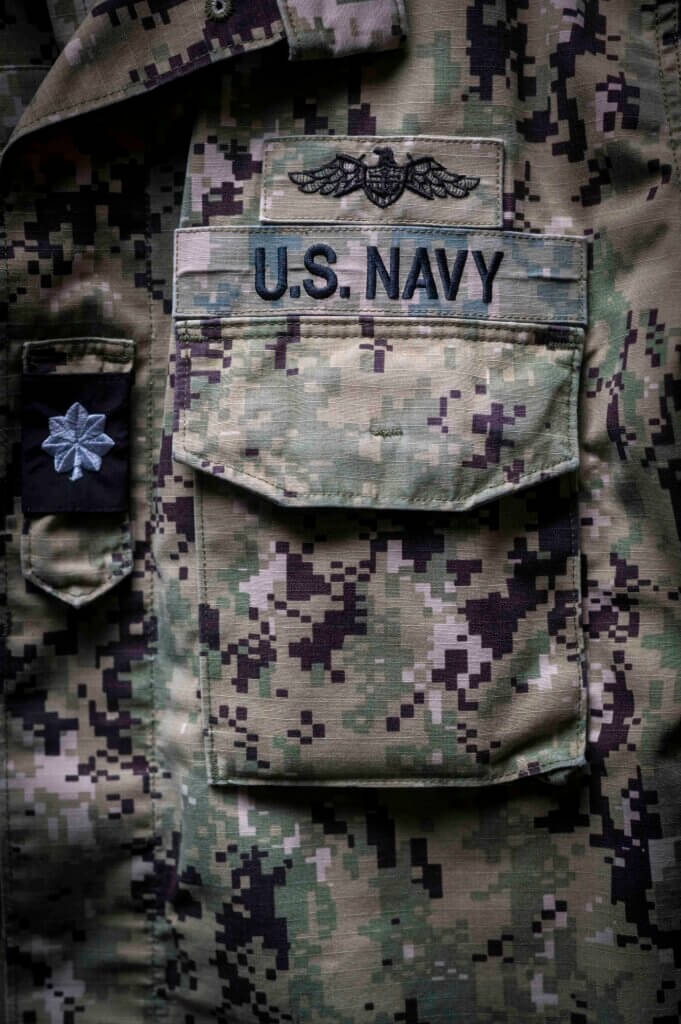It’s been more than 80 years since John Wayne portrayed the gruff merchant mariner Ole Olsen in the 1940 classic “The Long Voyage Home.”
Told from a merchant mariner’s perspective, the film focuses on the anxiety and danger cargo ships faced delivering supplies from the U.S. to Europe during the beginning of World War II.
More than 36,000 allied sailors died moving men, ammunition and supplies across the ocean in the Battle of the Atlantic.
Today, a small group of Naval Reserve officers stand ready to crew U.S. merchant ships in the event of a shooting war.
They’re called strategic sealift officers (SSO), and serve in the Individual Ready Reserve.
“We’re merchant mariners first, as well as being naval officers.” said Lt. Commander William Welch, an SSO on the Pacific coast. “So the majority of [SSOs] are out at sea operating container ships. Then they come back when their civilian tour is over and then do their two weeks of Navy service.”
Although there are less than 2,000 of these officers in the Navy, SSOs fill several niche – yet vital – roles. Each are graduates of one of the country’s few maritime academies. They are also graduates of naval reserve officer training corps programs and volunteered for this duty.
Their first responsibility is to be available in case of war. In the event the U.S. needs to ship arms and supplies overseas, SSOs are called on first to fill empty spaces on U.S. cargo ships. This ensures the vessels the U.S. needs to move its cargo are manned and ready.
RELATED: Northern Strike winter iteration prepares units for emerging threats
SSOs also bring a plethora of knowledge to the fleet. They are line officers and wear distinct gold stars on their shoulder boards. During their two weeks of active service a year, SSOs are on several warships.
Recently Welch, who sailed as a civilian mariner for several years with Military Sealift Command, was assigned to work with Expeditionary Unit 3 in San Diego.
There, the seasoned civilian engineering officer found himself working side by side with enlisted sailors and officers of the electrical department on board the USS Makin Island.
“I was showing them how I troubleshoot and work engineering issues on the merchant side, and I was learning a lot from them,” he said.
Because of their expertise in seafaring, SSOs have also helped Navy commanders improve the performance of their bridge crews.
Unlike traditional surface warfare officers, SSOs obtain a maritime-relevant degree during their time at maritime academies, and also spend a significant time at sea. When they first enter the fleet, they’ve already had four tours afloat.
“From Day One, I was proficient with the ship’s systems,” Welch said. “I could walk on any ship and be like, ‘OK, I have my head on straight about this.’”
After several incidents involving collisions between civilian vessels and the U.S. Navy ships, groups of eight to 10 SSOs were embarked onboard U.S. warships. Once aboard, these officers helped commanders streamline and improve operations on the bridge.
They also provided the crew with knowledge about how civilian ships operate and advised them on the best practices when operating a warship in highly trafficked civilian waters.
“Navy ships are highly powerful and highly maneuverable,” Welch said. “But civilian ships are not.”
Sometimes, he said, there’s a tendency for Navy ships to be overconfident in maneuverability and skill of some foreign merchant ships. Other SSO officers work closely with fleet headquarters and provide commanders with subject matter expertise regarding merchant marine operations in their area of responsibility.
“We translate to the U.S Navy what the U.S. merchant shipping picture looks like,” said Cmdr. Kathleen Dipietropolo, an SSO currently assigned to naval units in Europe.
For Dipietropolo, some of that work is helping commanders and decision makers understand what the merchant shipping picture looks like in Black Sea, which has seen naval combat between Russia and Ukraine since 2022.
Everything from which country a ship is flagged under to the normal traffic patterns of shipping lanes are examined and interpreted by SSOs to provide theater commanders with the most complete picture possible.
But war is not the only time when SSOs are called upon. As Dipietropolo said, oftentimes SSOs play vital roles in organizing humanitarian efforts across the globe in the wake of natural or manmade disasters by finding suitable ports in navigable waterways.
For Dipietropolo, these missions are why she is still drawn to the sea.
Merchant shipping, she said, “affects every human being on the planet, and when it doesn’t happen correctly, we know it.”

